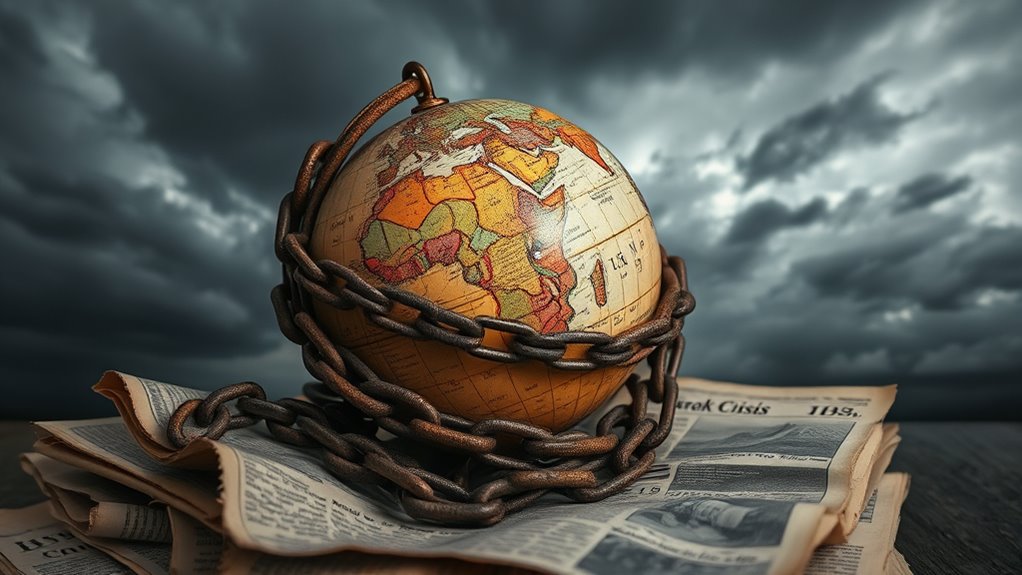To protect your money from global crises, learn from history’s lessons. Diversify your assets across regions and classes like stocks, bonds, real estate, and commodities to reduce risks. Maintain liquidity reserves and choose secure banks with strong reputations. Keep an eye on early warning signs such as inverted yield curves and market volatility. By understanding past failures and adjusting your strategies accordingly, you can build resilience—discover how to fine-tune your approach for better security.
Key Takeaways
- Diversify assets across regions, sectors, and classes to reduce dependency on any single market or currency.
- Maintain liquidity reserves in secure, reputable accounts to ensure access during economic downturns.
- Hedge against currency and regional risks by holding assets in multiple currencies and in stable jurisdictions.
- Study historical crises to identify warning signs like inverted yield curves and stock declines, enabling proactive adjustments.
- Develop flexible, well-informed financial plans incorporating lessons from past crises for resilience amid uncertainty.
Understanding the Roots of Financial Turmoil

Understanding the roots of financial turmoil, recognizing how sovereign debt defaults have historically triggered crises is essential. In earlier centuries, governments often failed to repay their public debts, causing widespread instability. These defaults led to bank failures as the financial system absorbed the shock, spreading economic distress. Currency debasement and hyperinflation further destabilized economies by effectively repudiating debts, eroding savings, and undermining confidence. Since the 18th century, crises have involved both public and private debt defaults, creating broader economic turmoil. The interplay between sovereign defaults and private credit collapse has been a hallmark of many historic crises, showing how government failures can trigger cascading failures throughout financial systems. Recognizing this history helps you grasp the importance of fiscal responsibility and stability in protecting your money. Sovereign defaults have often been accompanied by currency crises, illustrating the interconnectedness of fiscal and monetary stability. Recognizing the patterns of financial system vulnerabilities reveals how interconnected economic factors can amplify crises and destabilize wealth.
Recognizing the Signatures of Major Crises

Major financial crises often leave behind clear warning signs that can help you recognize trouble ahead. One key indicator is the inverted yield curve, where short-term bonds yield more than long-term ones, signaling an upcoming slowdown. Historically, every U.S. recession since the 1970s followed such an inversion, with a lead time of 6 to 24 months. Rising unemployment also signals trouble; when the 3-month unemployment rate rises by 0.5 percentage points from its recent low, a recession may be near. Additionally, sharp stock market declines—20% or more—and increased volatility often precede downturns. Look for these signatures in tandem, as shown below:
| Indicator | Signal | Impact |
|---|---|---|
| Inverted Yield Curve | Short-term yields > long-term yields | Expect slowdown, rate cuts |
| Rising Unemployment | 0.5% increase in 3-month average | Reduced consumer spending |
| Stock Market Declines | 20% drop from peak, rising VIX | Diminished confidence |
An inverted yield curve, in particular, is considered a reliable predictor of recessions, as it reflects investor expectations of lower growth and inflation.
How Governments and Central Banks Responded

When financial crises strike, governments and central banks act swiftly to stabilize markets and support the economy. They deploy massive bailouts and liquidity injections, buying trillions in assets to prevent collapse. During the 2008 crisis, the Federal Reserve purchased about $2.5 trillion in assets and bought preferred stocks in major banks, injecting essential funds. Central banks also lowered interest rates near zero and used quantitative easing to purchase securities, lowering long-term rates and encouraging lending. Governments increased spending, backed bank deposits, and took equity stakes to restore confidence and prevent failures. New regulations tightened oversight, reducing risky behaviors. Central banks expanded their roles, coordinating internationally to manage crises more effectively. These aggressive responses aimed to contain damage and stabilize the financial system. These measures were crucial in preventing a complete economic breakdown and restoring a degree of stability to global markets. Additionally, the use of AI-driven solutions in financial analysis has begun to enhance crisis prediction and management, indicating a shift toward more advanced technological interventions in economic stability efforts. The integration of financial technology has further supported rapid decision-making during turbulent times. Moreover, understanding the history of economic crises helps policymakers develop more effective strategies for future challenges.
Strategies to Safeguard Wealth During Uncertainty

To safeguard your wealth during uncertain times, you should diversify your asset holdings across different regions and asset classes. Keeping sufficient liquidity reserves ensures you’re prepared to act quickly or handle unexpected expenses. By balancing these strategies, you can better withstand market fluctuations and safeguard your financial future. Global diversification also helps protect your assets against economic crises, currency devaluations, and political instability. Incorporating risk management strategies can further enhance your financial resilience during turbulent periods. Additionally, understanding the trustworthiness of your chosen brands can ensure your investments and assets are protected from potential fraud or misrepresentation. Regularly reviewing your portfolio and staying informed about market conditions can help you adapt your approach proactively.
Diversify Asset Holdings
Diversifying your asset holdings is a key strategy to protect your wealth during times of global uncertainty. By spreading investments across stocks, bonds, real estate, and commodities, you reduce reliance on any single asset’s performance. Stocks tend to grow during bullish markets, while bonds offer stability during recessions, balancing risk. Real estate provides an inflation hedge and rental income, independent of stock and bond fluctuations. Commodities can shield you from currency devaluation and inflation. Including emerging assets like cryptocurrencies adds diversification but comes with higher volatility. Within each asset class, diversify across sectors and maturities to manage sector-specific risks and interest rate changes. Geographic diversification further minimizes regional shocks, providing resilience by spreading exposure across different economies. A well-rounded, diversified portfolio helps you withstand unpredictable global crises. Historical data shows that diversified portfolios tend to recover faster and suffer smaller losses during downturns, reinforcing the importance of broad asset allocation and strategic diversification. Incorporating AI-driven data analytics into your investment strategy can further enhance your ability to identify emerging opportunities and adapt to market changes swiftly. Additionally, understanding the importance of risk management can help you make informed decisions that align with your financial goals.
Maintain Liquidity Reserves
Maintaining adequate liquidity reserves is a vital part of safeguarding your wealth during times of global uncertainty. Liquid reserves give you immediate access to cash, helping you cover emergencies without forced asset sales in downturns. They cushion market volatility and economic shocks, preserving your wealth. Having 3-6 months of essential expenses in cash or cash-like assets ensures short-term solvency. Diversifying your reserves across FDIC-insured accounts, Treasury-backed funds, and whole life insurance cash values reduces risk. Short-term U.S. Treasuries and money market funds offer safety and liquidity, while keeping funds in multiple institutions avoids concentration risk. Regularly review your liquidity targets, balancing the need for immediate access with inflation considerations and long-term growth. Maintaining liquidity helps you stay prepared for unforeseen events and minimizes the need for disruptive asset liquidations. Incorporating liquidity management strategies can further optimize your reserve holdings and improve your overall financial resilience. Additionally, understanding the role of eye patches can serve as a metaphor for protective measures—just as eye patches shield and rejuvenate the delicate skin around the eyes, prudent liquidity reserves shield your financial health from unexpected crises. Incorporating risk mitigation strategies into your planning can enhance your ability to respond effectively to economic shocks.
Learning From Past Policy Failures and Successes

Learning from past policy failures and successes is essential for protecting your money during global crises. The Great Depression showed that contractionary policies can worsen downturns, while timely fiscal stimulus and financial regulation helped restore stability. During the 1970s oil crisis, rigid monetary responses to supply shocks deepened recession, highlighting the need for flexible policies. The 2007-2009 financial crisis revealed that lax regulation and excessive leverage can trigger systemic collapse, emphasizing the importance of transparency and oversight. The Savings and Loan crisis demonstrated that deregulation without risk management risks instability, while the early 1980s rate hikes proved that tough monetary measures can curb inflation, even if they cause short-term pain. Learning from these lessons helps you understand how effective policies can safeguard your investments during crises. Understanding how different policy responses impact economies is crucial for making informed financial decisions during turbulent times. Additionally, recognizing the importance of financial regulation can help prevent future crises and protect your assets from systemic risks. Recognizing how cybersecurity vulnerabilities can be exploited during crises underscores the need for robust security measures to safeguard financial information and assets.
The Role of Diversification and Asset Allocation

Understanding how past policy mistakes and successes impact market stability underscores the importance of strategic investment choices today. Diversification reduces your portfolio’s volatility by spreading investments across uncorrelated assets, lowering risk during crises. Historically, balanced portfolios combining stocks and bonds experience smaller, less severe downturns than all-stock portfolios, with bonds often providing a cushion when stocks fall. Truly effective diversification includes real estate, commodities, and cash, further shielding you from systemic shocks. Asset allocation—adjusting your mix of stocks, bonds, and other assets—helps optimize risk and return based on your risk tolerance and time horizon. During crises, well-balanced portfolios typically outperform concentrated ones, with diversified assets rebounding faster and offering more stability, especially when adjustments are made as market conditions change. Incorporating home decor & design strategies can also enhance your living environment, promoting resilience and comfort during turbulent times.
Preparing for Currency and Banking Instability

To safeguard your money during times of currency and banking instability, start by diversifying your currency holdings. Using secure banking options, such as internationally reputable institutions, can help protect your assets from local crises. Staying proactive with these strategies ensures you’re better prepared for sudden financial shocks. Maintaining sufficient reserves and confidence in core economies’ policies is crucial for currency stability, so keeping informed about global economic developments can further help you make sound financial decisions.
Diversify Currency Holdings
Diversifying your currency holdings is a crucial strategy to protect your wealth from global economic and banking crises. By spreading your assets across multiple currencies, you reduce risks linked to currency depreciation or banking failures in a single nation. Large investors and central banks diversify reserves to stabilize exchange rates and lessen reliance on the US dollar. Key currencies like the euro, yen, renminbi, and others are considered for their stability and convertibility. Holding physical foreign currency offers quick access in emergencies but needs secure storage, while ETFs and mutual funds provide indirect exposure. Currency hedged funds, forward contracts, and foreign real estate investments also help shield your wealth. This approach signals confidence to markets and boosts your resilience during turbulent times.
Use Secure Banking Options
Preparing for currency and banking instability requires selecting robust and well-regulated financial institutions. Choose banks with strong balance sheets, high liquidity, and solid capital buffers that can absorb shocks. Guarantee they undergo regular stress tests and operate under strict regulations to boost resilience during crises. Opt for banks in jurisdictions with high credit ratings, stable political environments, and extensive deposit protection schemes. Consider offshore accounts in countries like Switzerland or the Netherlands, known for their financial stability and strong legal frameworks. Additionally, prioritize banks with advanced cybersecurity measures to guard against cyber threats and IT disruptions. Look into custodial accounts or institutions offering extra protections beyond standard deposit insurance to safeguard your assets against insolvency or systemic failures.
Building Resilience Through Informed Financial Planning

Building resilience through informed financial planning requires you to regularly assess and manage risks that could threaten your financial stability during global crises. This means conducting exhaustive risk assessments to identify exposure to currency fluctuations, political instability, market volatility, and supply chain disruptions. You should continuously review and adjust your portfolio to mitigate potential losses, adapting your strategies to shifting geopolitical and economic conditions. Diversification across asset classes, regions, and defensive assets like gold or bonds reduces dependence on any single market or sector. Staying aware of central bank policies and government interventions helps you anticipate market impacts. Learning from historical crises, you’ll understand that recovery can be slow and that flexible, well-informed plans are essential for weathering uncertainty and safeguarding your financial future. Historical events influence current risk assessments, highlighting the importance of incorporating past lessons to strengthen your financial resilience.
Frequently Asked Questions
How Can I Predict the Next Global Financial Crisis?
To predict the next global financial crisis, you should monitor key economic indicators like the US Leading Economic Index, watching for persistent weakness and signals of recession. Pay attention to rising trade tensions, policy uncertainty, and declining global growth forecasts. Keep an eye on labor market signals, such as rising jobless claims, and fiscal pressures like increasing deficits. These signs often precede financial downturns, helping you stay prepared.
What Are the Best Assets to Hold During Economic Downturns?
Imagine you’re steering through a storm—certain assets act as your lighthouse. During downturns, holding government bonds offers safety and steady returns, much like a sturdy ship in rough seas. Defensive stocks, like healthcare, provide resilience. Gold and precious metals serve as your insurance against volatility and inflation. Keeping cash on hand guarantees flexibility, enabling you to seize opportunities when prices are low. Together, these assets help safeguard your wealth through economic storms.
How Effective Are Government Bailouts in Protecting Individual Investors?
Government bailouts can help protect individual investors by preventing corporate bankruptcies and reducing defaults, which keeps asset values more stable. However, their effectiveness varies; large bailouts often benefit big institutions more than small investors, and some programs may favor certain regions or sectors. While bailouts can mitigate immediate losses, they don’t eliminate long-term risks or moral hazards, so diversifying your investments remains essential.
Can International Cooperation Prevent Global Financial Collapses?
You might think international cooperation can prevent global financial collapses, but history shows it’s not foolproof. While organizations like the IMF promote coordination and provide support during crises, countries often act mainly in their own interest. This limits full prevention, as national priorities and political decisions still drive responses. Still, cooperation helps reduce uncertainty and stabilizes markets, making a total collapse less likely but not impossible.
What Personal Financial Measures Can Shield Me From Currency Devaluations?
You can shield yourself from currency devaluations by diversifying your currency holdings across stable nations, including foreign cash and accounts. Invest in hard assets like gold, silver, or real estate that hold value during devaluations. Use hedging strategies such as currency futures or options to lock in rates. Keep liquid reserves in stable foreign currencies for quick access, and consider global investments to reduce reliance on your home currency.
Conclusion
So, next time the markets wobble and your investments look spookier than a horror flick, remember history’s lessons—diversify, stay informed, and don’t put all your eggs in one fragile basket. After all, if you think financial crises only happen to “those other” people, just wait. Protect your money wisely, or you might find yourself wishing you’d listened to the ghosts of economic past when they come knocking again. Stay prepared, smarty!









